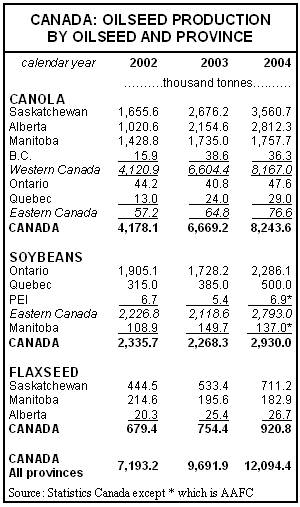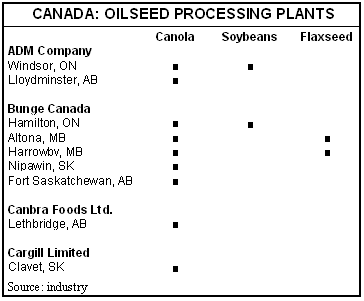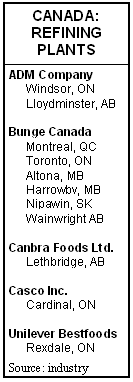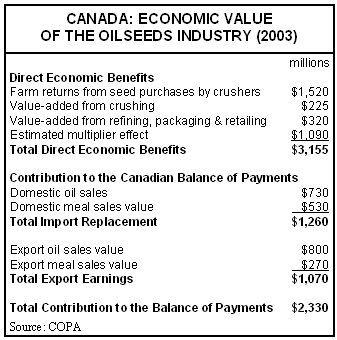Publications: Bi-weekly Bulletin
2004-08-20 | Volume 17 Number 13 | ISSN 1494-1805 | AAFC No. 2081/E
Profile of the Canadian Oilseeds Sector: Part 1
Profile of the Canadian Oilseeds Sector: Part 2
The oilseeds sector in Canada is a major contributor to the economy of Canada in terms of value-added and employment. Total direct economic benefits of the industry to the Canadian economy were $3.2 billion (G) in 2003. In western Canada, canola and flaxseed have traditionally been the major oilseeds but the importance of soybeans and mustard seed has been steadily increasing. In eastern Canada, soybeans continue to be the dominant oilseed where the role of identity preservation has increased significantly. This issue of the Bi-weekly Bulletin provides an overview of the production sub-sector and the processing sub-sector. A subsequent issue will examine the marketing sub-sector and the organizational structure of the industry.
The Canadian oilseeds sector, consisting of canola, soybeans, flaxseed, sunflower seed, mustard seed and safflower seed, can be divided into three distinctive components. These are: (a) production - covering farm production and farm storage; (b) processing - covering crushing, refining and further processing for the production of oils, protein meals and finished products; it includes bottling and packaging operations; and (c) marketing - covering trade, distribution, exporting and hedging of oilseeds and their products.
Oilseed production in Canada is regional
Canola (spring types), flaxseed (including solin), sunflower (oil and confectionery types) and mustard seed are grown mainly in the three Prairie Provinces (Manitoba, Saskatchewan and Alberta) and in the Peace River Region of British Columbia. A small acreage of canola is grown in Ontario. Soybeans, in Ontario, and to a lesser degree Quebec and Manitoba, are grown mostly for crushing but significant amounts are also destined for the Asia soyfood market. In Quebec, Manitoba and the Maritime provinces, some soybeans are also grown and roasted on farms for whole bean livestock feed.
The sustained Canadian research commitment to develop new and improved varieties may make the production of oilseed crops less regional. The introduction of canola varieties suitable to conditions in eastern Canada and more soybean varieties suitable for Quebec and Manitoba are evidence of this trend. The use of genetic modification techniques to expand the diversity and speed up the development of improved cultivars has become wide spread. Canada is the global center for canola breeding.
Canadian oilseed (canola, soybeans, flaxseed) production reached a high of 12.6 million tonnes (Mt) in 1999 due to excellent yields. Drought and low yield for 2001 and 2002 reduced production to 7.4 Mt and 7.2 Mt respectively. In 2003, oilseed production rebounded to 9.7 Mt due to an increase in seeded area and slightly higher yields.
Producers have the option of either marketing their oilseeds directly to a processing (crushing) firm or to move them into the elevator system from where it may go to domestic or export customers. The primary and inland elevator system has traditionally gathered supplies of oilseeds for the export markets but in the last few years has become a supplier to the growing processing sector.
Canola is the dominant oilseed in western Canada
In the 1970s, canola seed production and utilization were subject to considerable fluctuations from year to year. During the 1980s, such fluctuations decreased and production took on a growth trend. However, seed production remains dependent on weather conditions, crop rotation requirements and international commodity prices, while domestic utilization is dependent on crushing margins (the difference between the cost of seed and the value of canola oil and meal). A positive combination of all these factors led to record production of 8.8 Mt in 1999. Unfavourable weather conditions in 2001 and 2002 led to a reduced production of 4.9 Mt and 4.2 Mt respectively. For 2003, production rebounded to 6.7 Mt due to more favourable weather conditions and a sharply higher seeded area.
There are approximately 60,000 producers of canola in Canada. Canola is a strong second to wheat as Canada's most valuable crop. New varieties offer the potential to expand production into drier regions of Western Canada. In addition, varieties with special traits, developed using biotechnology, offer the possibility of significant yield increases. Canola seed moves to the export market through an extensive handling and processing chain.
Domestic processing of canola seed experienced a dramatic expansion in the 1990s. There was extensive corporate restructuring and consolidation while at the same time crushing facilities were modernised and expanded. In the 2003-2004 marketing year, a record 3.3 Mt of canola was crushed on support from extremely high crush margin. A slightly smaller volume is expected to be crushed for the 2004-2005 crop marketing year.
Soybeans are the dominant oilseed in eastern Canada
By 1950, soybeans had become a major cash crop in Ontario. During the 1980s, soybeans were introduced into Quebec, Manitoba and the Maritime Provinces as a source of livestock feed. Due to the presence of enzymes, soybeans must be roasted before being fed to livestock. In Quebec, whole roasted soybeans have become a viable alternative feed source. Research is underway to reduce or eliminate the need to roast whole soybeans before feeding.
In recent years, Canadian plant breeders have developed varieties of soybeans with the qualities required by specific soyfood markets of the Asia Pacific region. In both Ontario and Quebec, food quality varieties of soybeans, mostly known as Special Quality White Hilum Beans, are grown to be exported for further processing into tofu, natto, miso and tempeh in Asian markets.
Canadian soybean production has increased sharply from the late 1970s when up to 60% of Canadian soybean requirements were imported. Today, domestic production is enough to supply the Canadian demand for crushing into soyoil and soymeal, as well as leaving a surplus of approximately 0.7-0.9 Mt for export. Over 80% of soybean exports are identity preserved which are sold on world market for a substantial premium. Despite the increase in soybean crush, Canada remains a net importer of soy products. In 2002-2003, Canada imported about 0.13 Mt of soyoil and about 1.0 Mt of soymeal.
Flaxseed's role in health food market has increased
Flaxseed was the first oilseed to be widely grown in western Canada and was used as a "break crop" in virgin soil. Today, the unique properties of flaxseed differentiate it from other oilseeds in the industrial, human food and livestock feed markets. Currently, industrial uses of linseed oil are the dominant source of world demand for flaxseed, with human food requirements a distant second.
Most countries, other than those in North America, refer to flaxseed as linseed. In Europe, flaxseed refers to the tall, long fibre varieties of the crop produced for the linen textile industry, while linseed designates the varieties used for oil and livestock meal. In Canada, the vast majority of flaxseed produced is of the short fibre oilseed varieties. The Canadian flaxseed crop is mainly grown in the western provinces of Alberta, Saskatchewan and Manitoba. Canada also grows solin, a type of flaxseed that has a fatty acid profile similar to sunflower oil.
Demand for flaxseed has also undergone major shifts over the last century. On the industrial side, the demand for linseed oil has dropped significantly since the 1950s largely due to the introduction of new technological developments, such as the increased use of water based paints and petroleum based floor coverings. However, in the late 1990s, the trend towards environmentally friendly and health oriented products began to open new opportunities for the flaxseed industry. The biodegradability and non-allergenic characteristics of linoleum, along with quality improvements, has seen the resurgence of demand for linoleum in some parts of Europe.
Demand for flaxseed is also growing in several key niche markets, including the North American baking industry and the egg industry. The egg industry is feeding laying hens flaxseed based rations that effectively improves the dietary characteristics of the eggs. Hens fed a flaxseed based diet produce eggs with an improved omega-3 fatty acid profile. Feeding trials are being held for hogs and cattle to ascertain the benefits of flax as a feed ingredient. Health professionals have indicated the omega-3 fatty acids have benefits for humans.
Like the seed, flax straw has a diverse range of uses from raw material for specialty pulps and oriented strand board, or as an alternate fuel source. From a further value added perspective, flax fibre can be used in geotextiles, absorbent products, insulation and lastly in textiles (e.g. linen blend products).
Other oilseeds are also important
Sunflower seed is mainly grown in southern Manitoba and south-eastern Saskatchewan. However, it has not become a major source of vegoil in Canada. Canada produces both confectionery and oilseed types of sunflower seed, and is a competitive partner in the growing international market for this special crop. The hardy sunflower has a wide range of uses, from the confectionary and baking industries, to the birdseed industry, to the animal feed industry. In 1997, production of sunflower seed was only 65 thousand tonnes (kt) but the volume of sunflower seed production reached 157 kt in 2002.
Production dropped in the mid-1990s because the Altona, Manitoba plant ended crushing. It has been increasing since then due to increased processing for bird seed and food uses.
Mustard seed production is concentrated in the Prairie Provinces, particularly in Saskatchewan, which accounted for approximately 80% of mustard seed production in 2002. Production averaged 230 kt throughout the 1990s. Production declined in 2001 to 105 kt due to reduced seeding and negative weather conditions. Seeded acreage returned to normal in 2003 however production was only 226 kt, being once again affected by unfavourable weather. Canada is the world's single largest exporter of mustard seed.
Safflower seed is grown in all three Prairie Provinces but over the past few years, production has ranged from 1 to 8 kt. Canadian safflower seed is used for bird seed. Safflower oil contains more polyunsaturates than any other oil and has a high smoke point (which makes it excellent for deep frying). Safflower oil is not as nutritionally beneficial as some of the other oils, as it lacks vitamin E.
Crush capacity in Canada remains stable
The oilseed processing industry in Canada currently consists of nine plants owned by four companies that receive and crush oilseeds to obtain crude and crude degummed vegoils (from canola, soybeans, and flaxseed) as well as protein meals for animal feed. Annual crush capacities are 4.0 Mt of canola, 2.0 Mt of soybeans, and 1.0 Mt of flaxseed.
Oilseed Processing Plants
In 2001, the latest year for which data are available, the Canadian oilseed industry was suffering from reduced production due to drought. In 2001, the oilseed crushing industry employed 1,004 people, down 6% from 1997. In 2001 the oilseed processing industry purchased materials and supplies, mainly oilseeds for processing, valued at $1.4 G, down by 29% from 1997. The total value of shipments was $1.6 G in 2001, down 33% from 1997. The value-added component for the industry was $172 M in 2001, down 61% compared to 1997.
There are two main methods of processing oilseeds in Canada
To extract the oil from the meal there is the pre-press solvent extraction, which is used for higher oil content oilseeds such as canola, sunflower seed and flaxseed and the direct solvent extraction method which is used for lower oil content oilseeds such as soybeans. Except for the presence of the mechanical expeller in the pre-press solvent extraction method, the steps followed are basically the same.
In pre-press solvent extraction, the seeds are first flaked and heated for easier oil extraction, and then passed through the screw press. This squeezes out a large proportion of the oil, which is routed to a settling tank. The remaining oil cake is reground and sent to the solvent extractor, in which a solvent dissolves the oil from the meal. The oil is separated from the solvent by distillation. The solvent is recycled and the crude oil is sent on to be refined. Most Canadian canola oil is processed this way.
Oil extraction using the direct solvent method is essentially the same as described above, except that after the initial flaking and heating operation, the material is sent directly to the solvent extractor.
Canada crushes mainly canola and soybeans
The two major oilseeds processed in Canada are canola and soybeans, with small amounts of flaxseed also being crushed. In 2003, canola crushings accounted for 60% of total oilseed crushings, with soybean crushings accounting for 38%.
In 2003, Canadian oilseed crushings were 4.5 Mt, down 9% from the record set in 1998. Canola crushings were 2.7 Mt in 2003, down 21% from the record crush of 3.4 Mt in 1998. Soybean crushings in 2003 totalled a near record 1.7 Mt. In 2003, Canada accounted for 8% of total world rapeseed/canola crushings, compared with 4% for flaxseed and1% for soybeans.
Oil and meal are the main products
The oil and meal contents of the different oilseeds vary considerably. Canola is crushed mainly for its oil while soybeans are processed primarily for the meal.
Growing conditions can influence these percentages from year to year. Differences in oil and meal content have a marked influence on the oil extraction processes most suitable for each oilseed and on the marketing of the resulting products. Each year, the Canadian Grain Commission (CGC) analyses these crops for their quality factors. CGC quality data is usually available a month or two after harvest.
Canada produces mostly canola oil and soyoil
In 2003, total vegoil production in Canada was 1.5 Mt, down 13% from the record of 1.8 Mt set in 1998. In 2003, canola oil accounted for 74% of total vegoil production and soybean oil for 21%.
In 2003, 1.0 Mt of vegoils were used domestically in Canada, up 1% from the record domestic use in 2000. Canola oil accounted for 34% of total domestic use of vegoils in 2003, compared with 42% for soybean oil, 4% for sunflower oil and 3% for linseed oil.
Canola, soybean and sunflower oils are generally refined to produce salad and cooking oils, shortening oils, and oils for margarine, while linseed oil is used for industrial purposes such as in paint manufacturing. Refining removes the natural impurities to improve colour, flavour and shelf life.
Oil refining
Total refining capacity in Canada is 1.2 Mt annually. During the refining process, the crude oil may be degummed, a process which removes the hydrateable gums by a water-degumming operation. The gum by-products are used in the manufacturing of soap or as a food supplement, or are further processed to extract lecithin. Afterwards, either the crude or the crude degummed oil is treated with phosphoric acid and mixed with sodium hydroxide in a continuous centrifugal alkali-refining operation. The refined oil is then bleached to remove colour pigments and chlorophyll and is winterized if necessary. This last step prevents clouding when the oil is cooled. Hydrogenation is an optional process that is used to adjust the consistency of the oil according to the physical properties desired, i.e. degree of hardening required by final products such as margarine and shortening.
The bleached oil, hydrogenated oil or various combinations of these oils are then deodorized to remove flavours and odours. The resulting oils are used to produce finished products such as salad/cooking oils, margarine and shortening.
The estimated Canadian deodorizing capacity is 929,000 tonnes per year. Deodorized oils in Canada are primarily utilized in three main products: margarine oil, shortening oil and salad oil. Canola oil has the overwhelming market share (about 80%) of the salad oils and also is the leading source (57%) of shortening oil. Soyoil predominates in the production of margarine oil. This utilization trend is quite stable.
Canola oil is a healthy oil
For the salad oil market, canola oil's nutritional properties allow it to dominate the market. Of the commercially available edible oils, canola oil contains the lowest levels of saturated fat (6%), the second highest level of monounsaturated fats (58%) and the highest level of the essential fatty acid, linoleic acid (10%). In 1986, canola oil was awarded GRAS (Generally Recognized As Safe) status in the United States (US), opening a potentially large market for the oil. In the next year, a pure canola oil brand, Puritan Oil, won the "Food Product of the Year" from the American Health Foundation. The following year, this brand was recognized by the American College of Nutrition who granted its "Product Acceptance Award."
Canada develops specialty oils which require no hydrogenation
On July 11, 2003, the US Food and Drug Administration announced that it would amend its regulations on nutrition labelling to regulate that trans-fatty acids be declared in the nutrition labelling of conventional foods. This regulation would become effective January 1, 2006. In Canada, this labelling requirement comes into effect January 1, 2005. In response to this regulation and the perceived market opportunities it may create, the Canadian oilseed industry is embarking on a multi-prong initiative. The canola producers and processors are promoting the low-saturated fat content of current conventional varieties, while private canola breeding companies in Canada are breeding high-oleic, low-linolenic, canola varieties. These specialty oil varieties do not require hydrogenation, a process which partially hardens a vegetable oil and creates trans-fats. The high-oleic, low-linolenic canola oil can also be used in deep frying allowing canola oil to diversify out of the salad or cooking oil segment of the edible oil market where it is now mostly consumed.
Protein meal is a major livestock feed ingredient
Total protein meal production in Canada in 2003 was 3.1 Mt versus the record of 3.4 Mt in 1998. Historically, Canada was a net importer of protein meal but has exported significant volumes of protein meal in recent years.
In 2003, a near record 2.9 Mt of meal was used domestically in Canada, down 2% from the previous record of 3.0 Mt in 2001. Canola meal accounted for 19% of total domestic use of vegetable protein meals in 2003, compared with 80% for soymeal.
Value-added benefits from the sector are high
The oilseed crushing industry makes a large and positive contribution to the Canadian economy - it is a processing industry and as such it provides enhanced strength to the economy through value-added contributions and the financial multiplier effect. The direct economic benefits of the oilseed processing industry to the economy arise from: farm returns on seed purchases; value-added from crushing; value-added from refining, packaging and retailing; and an estimated multiplier effect.
The value of the processing industry as a domestic market outlet for producers was approximately $1.5 G in 2003.
Calculations based on Statistics Canada's data indicate that the value-added benefit of a crushing enterprise alone is equal to about $50 per tonne (/t), while the benefit from refining, packaging and retailing is approximately $100/t. Based on a 2003 crush of 4.5 Mt, the value-added benefit of the crushing industry was $225 M in 2003. In addition, the amount of crude canola, soybean and sunflower oils which were further refined in Canada in 2003 (0.9 Mt) contributed $320 M to the processing industry. The total value-added benefit of crushing and refining was, therefore, approximately $545 M in 2003.
Beyond the value-added benefit is the multiplier effect created by expenditures on oilseed products; this is estimated by economists to be 3; $2 of additional activity generated for each $1 of value-added activity at the processing level. Thus, a multiplier effect of $1.1 G can be added to the estimated $545 M value-added figure for 2003. Total direct economic benefits of the industry to the Canadian economy, as discussed above, were $3.2 G in 2003.
In addition to the direct economic benefits, the development of domestic supplies of edible oils and protein meals contributes positively to the Canadian balance of payments by reducing import requirements. This positive contribution was estimated to be, in 2003, the equivalent of $1.2 G. Exports of oils and meals also yield a positive contribution to the Canadian balance of trade. In 2003, this contribution was equal to $1.1 G. The total contribution to the Canadian balance of payments by the processing industry was $2.3 G in 2003.
Some modifications have been made for this Bulletin.
by
While the Market Analysis Division assumes responsibility for all information contained in this bulletin, we wish to gratefully acknowledge input from the following: Canola Council of Canada, Canadian Oilseed Processors Association, Flax Council of Canada, Ontario Soybean Growers, Market and Industry Services Branch (AAFC)
|
|
||
| Date Modified: 2006-12-08 |
|
|
|
[ Français | Contact Us | Help | Search | Canada Site ] [ AAFC Online | Links | Newsroom | What's New | Site Index ] |
||











